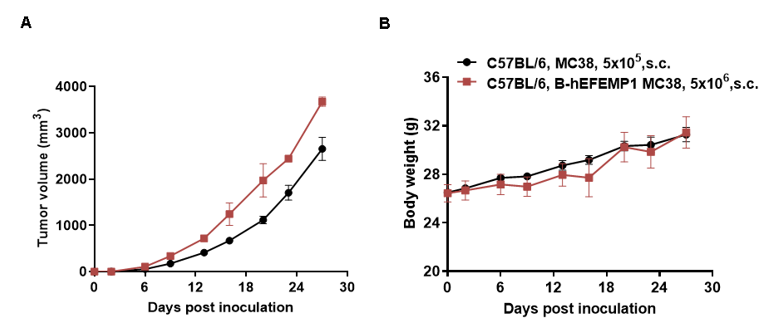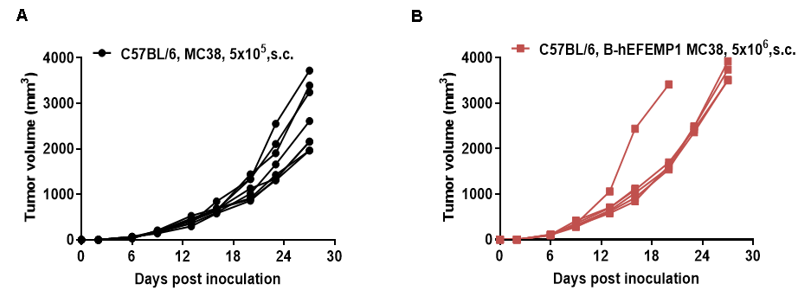B-hEFEMP1 MC38
|
Common name |
B-hEFEMP1 MC38 | Catalog number | 321926 |
| Aliases |
HDHRD; DRAD; FBNL; MLVT; MTLV; S1-5; FBLN3; FIBL-3 |
Disease | Colon carcinoma |
|
Organism |
Mouse |
Strain | C57BL/6 |
| Tissue types | Colon | Tissue | Colon |
Gene targeting strategy for B-hEFEMP1 MC38 cells. The exogenous promoter and human EFEMP1 coding sequence was inserted to replace part of murine exon 4. The insertion disrupts the endogenous murine Efemp1 gene, resulting in a non-functional transcript.

EFEMP1 expression analysis in B-hEFEMP1 MC38 cells by western blot. Human EFEMP1 was detected in the supernatant of B-hEFEMP1 MC38 cells but not wild-type MC38 cells. The 2-F12 clone of B-hEFEMP1 MC38 cells was used for in vivo experiments.

Subcutaneous homograft tumor growth of B-hEFEMP1 MC38 cells. B-hEFEMP1 MC38 cells (5x106) and wild-type MC38 cells (5x105) were subcutaneously implanted into C57BL/6 mice (female, 9-week-old, n=6). Tumor volume and body weight were measured twice a week. (A) Average tumor volume ± SEM. (B) Body weight (Mean± SEM). Volume was expressed in mm3 using the formula: V=0.5 X long diameter X short diameter2. As shown in panel A, B-hEFEMP1 MC38 cells were able to establish tumors in vivo and can be used for efficacy studies.

B-hEFEMP1 MC38 tumor cells growth of individual mice. B-hEFEMP1 MC38 cells (5x106) and wild-type MC38 cells (5x105) were subcutaneously implanted into C57BL/6 mice (female, 9-week-old, n=6). As shown in panel, B-hEFEMP1 MC38 cells were able to establish tumors in vivo and can be used for efficacy studies.











